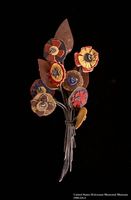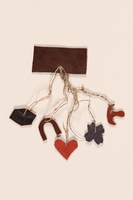Overview
- Brief Narrative
- The belt was created by Ruth Wiener from leather scraps found in her workplace in Bergen-Belsen concentration camp.
- Date
-
received:
1944
- Geography
-
received:
Bergen-Belsen (Concentration camp);
Belsen (Bergen, Celle, Germany)
- Credit Line
- United States Holocaust Memorial Museum Collection, Gift of Ruth Klemens
- Contributor
-
Subject:
Ruth Klemens
- Biography
-
Ruth Klemens (1927-2011) was born in Berlin to Alfred Wiener (b. 1885) and Margarethe Wiener (nee Saulmann, 1895-1945). They moved to Amsterdam in 1934 with her grandmother, Amalia Wiener. Around 1938 Alfred moved to London, and he relocated to the United States before Pearl Harbor. Ruth was deported to Westerbork with her mother and sisters, Eva and Mirjam, in June 1943. They were transferred to Bergen-Belsen in January 1944. They left in January 1945 for Switzerland as part of a prisoner exchange based on Paraguayan passports her father had purchased for them. Her mother died upon arrival in Switzerland, and Ruth and her sisters were transferred to Marseilles, where they were put on a boat to the United States in February 1945.
Physical Details
- Classification
-
Dress Accessories
- Category
-
Belts (Clothing)
- Object Type
-
Belts (Clothing) (lcsh)
- Physical Description
- The belt is made of interlocking loops of brown, red, and blue leather arranged in a pattern of alternating colors. There is no buckle or other fastening device.
- Dimensions
- overall: Height: 38.000 inches (96.52 cm) | Width: 0.875 inches (2.223 cm)
- Materials
- overall : leather
Rights & Restrictions
- Conditions on Access
- No restrictions on access
- Conditions on Use
- No restrictions on use
Keywords & Subjects
- Topical Term
- Holocaust, Jewish (1939-1945)--Germany.
- Corporate Name
- Bergen-Belsen (Concentration camp)
Administrative Notes
- Legal Status
- Permanent Collection
- Provenance
- The belt was donated to the United States Holocaust Memorial Museum in 1988 by Ruth Wiener Klemens.
- Record last modified:
- 2022-07-28 21:51:24
- This page:
- https://collections.ushmm.org/search/catalog/irn514961
Download & Licensing
In-Person Research
- By Appointment
- Request 21 Days in Advance of Visit
- Plan a Research Visit
- Request to See This Object
Contact Us
Also in Ruth Wiener Klemens collection
The collection relates to the life of Ruth Wiener Klemens, her mother, Margarete Wiener, and her sisters, Mirjam and Eva Wiener, during their time at Bergen-Belsen concentration camp in Germany and Westerbork concentration camp in the Netherlands.
Date: 1941-1943

Pin embroidered with a Star of David given to an inmate at Bergen Belsen for her birthday
Object
The pin was made by a friend and given to Ruth Wiener as a birthday gift at Bergen-Belsen concentration camp in Germany.

Bouquet of leather flowers made by an inmate at Bergen Belsen
Object
The bouquet was created by Ruth Wiener from leather scraps found in her workplace in Bergen-Belsen concentration camp.

Leather charm pin made from scraps by an inmate in Bergen-Belsen
Object
The pin was created by Ruth Wiener from leather scraps found in her workplace in Westerbork concentration camp.

Ruth Wiener Klemens papers
Document
The Ruth Wiener Klemens papers consist of biographical materials, registration correspondence and forms, and a Westerbork map and bath ticket documenting the status of the Wiener family from Berlin in Amsterdam, their deportation to Westerbork, and their transfer to Bergen‐Belsen. Biographical materials include identification cards, passes, notices, receipts, and a prescription documenting the Wiener family’s status in Amsterdam, their confinement at Westerbork, Ruth’s work harvesting potatoes and in the laundry, her sisters’ health, and their transfer to Bergen‐Belsen. Registration correspondence and forms include a registration form and instructions from the Jewish Council of Amsterdam, a notice from the Amsterdam Central Administration for Jewish Immigration for the Wiener family to make an appearance in order to protect themselves from forced labor camps, a letter from Erich August Paul Puttkammer that the Wieners had paid to be spared from deportation (a protective document with no actual value), and a receipt from the city of Amsterdam confirming that the Wieners were properly registered. The map of Westerbork was hand‐drawn and labeled in Dutch by Ruth Wiener. The bath ticket is an example of the bath passes issued to Westerbork inmates allowing them periodic baths.



